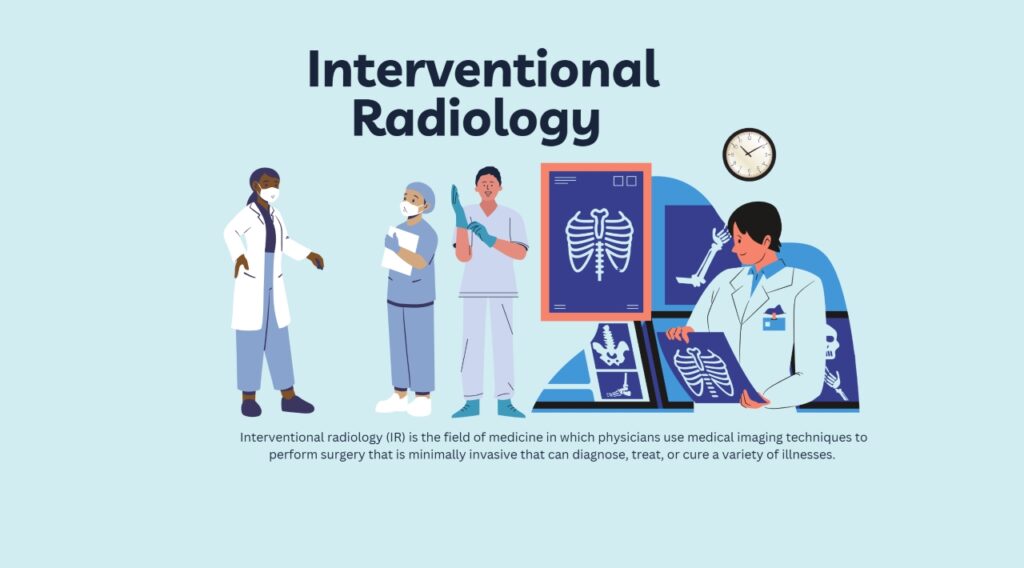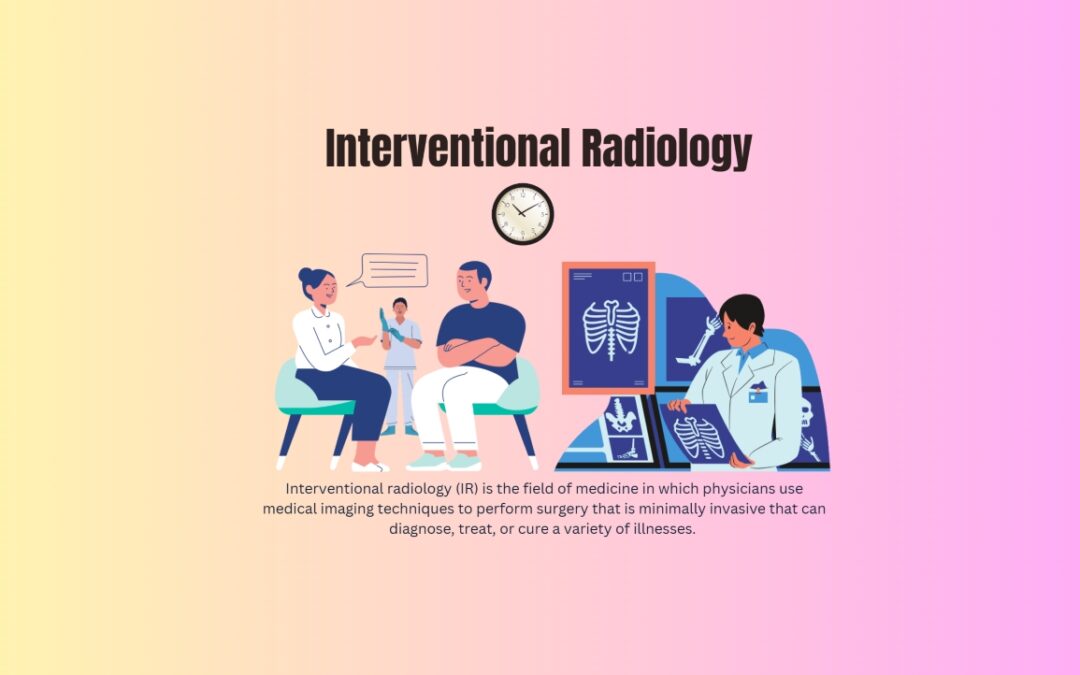Table of Contents
What is Interventional Radiology?
Interventional radiology (IR) is the field of medicine in which physicians use medical imaging techniques to perform minimally invasive surgery that can diagnose, treat, or cure a variety of illnesses. MRI, CT scan, and ultrasound are part of the imaging technologies used.
UVA Health System’s radiologists work in the Department of Vascular and Interventional Radiology. IR coding may be extremely complicated, with numerous areas of misinterpretation, including increased bundling of IR CPT® codes, IR coding hierarchies for different diagnostic tests, MUEs/MAIs, and more.
In a typical interventional radiology (IR) treatment, the patient lies on an operating table under a fluoroscope, a specialist X-ray machine. During the closely observing live medical images on a screen, the radiologist, using protective clothing like a sterile gown and mask, carefully inserts needles and wire-like instruments into the patient’s body. The radiologist accurately navigates the body without making major incisions thanks to this new imaging approach. In some cases, interventional radiology can eliminate the requirement for hospitalization.
Consultations vs. Office Visits
An interventional radiologist is a physician who has completed an authorized residency program and passed the American Board of Radiology exam. A consultation is a professional meeting where a practitioner assesses a patient and decides how best to treat them. Before a procedure, a patient may see an interventional radiologist (IR) for a consultation, office visit, or as a component of the operation.
Remember, a consultant’s opinion must be recorded in the patient’s documentation along with any prescribed or completed services. It is also necessary to compile and submit a written report of these observations to the referring physician. In other words, if the consultation is nomadic—that is, if the patient or family requests it rather than a doctor—it must be categorized using office visit codes rather than consultation codes.
Common Diseases Treat in Interventional Radiology
Interventional radiology (IR) can be used to treat few of most common diseases and injuries, such as:
- Heart disease (heart attacks)
- Peripheral arterial disease
- Cancerous tumors on the skin or internal organs
- Uterine Fibroids
- Needle biopsy
- Gastrostomy tubes
- Angioplasty
- Arthritis (inflamed joints)
- Pelvic congestion syndrome
- Intravascular ultrasound
- Deep vein thrombosis
- Embolization
Methods and Techniques in Interventional Radiology
IR professionals collaborate closely with other healthcare providers and play a vital role in the treatment process. Interventional radiologists perform a variety of operations targeted at specific bodily systems and ailments. Among them are:
- A common treatment for peripheral and coronary artery disease is angioplasty and stenting, which enlarges constricted or blocked blood vessels.
- Keep in mind that angiography is an X-ray of the arteries and veins used to detect vascular blockage or narrowing, among other problems.
- Embolization is a frequent treatment for conditions like aneurysms or fibroids that involves injecting drugs that block blood flow in a specific region. This can help to control bleeding.
- Gastrotomy tubes. If you are unable to take meals by mouth, the provider will insert a feeding tube into your stomach.
- In the biopsy process, radiologists may obtain tissues from nearly any body component for diagnosis using imaging direction.
- Drainage techniques are used to extract fluid from the body’s abscesses and other fluid accumulations.
- IVCfilters. The provider inserts a tiny filter into the inferior vena cava. This is a huge vein in your abdomen. The filter captures blood clots that may enter your lungs.
- In tumor ablation, malignant tissues are destroyed without the need for open surgery using methods like radiofrequency or cryoablation.
- Catheter insertions. The provider inserts a tube (catheter) into a big vein to administer chemotherapy drugs, nourishment, or hemodialysis. They may also insert a catheter before a bone marrow transplant.
- Central Venous Access involves putting catheters into big veins for dialysis, chemotherapy, or nutrition.
The Experience of Patients During IR Procedures
For patient comfort and safety, the environment in an IR procedure room is strictly regulated. The interventional radiologist guides instruments into the patient’s body while they are lying on the operating table with the aid of live imaging.
Patients and members of the medical staff should wear protective coverings because they help lower radiation exposure from imaging procedures like fluoroscopy. It is simple to observe what is going on thanks to all the controls and displays, and they swiftly make adjustments based on what appears on the screens. Because of their accuracy, they can execute intricate procedures with very small incisions, greatly lessening the physical strain of standard surgery.
Check if the service is billable separately
Global Period (GP) is used in the E&M solutions payment rules. The objective of an E&M visit is to determine whether a procedure is necessary. This GP begins on the day of surgery (or the day prior if it is a 90-day GP) and in accordance with the procedure’s CPT code. The duration of this global span might range from 0 to 10 days, and in certain situations, 90 days. E&M visits that are used to determine whether to perform a procedure can typically be billed and paid for if they take place outside of the GP’s office. The surgical package covers all procedure-related services for the duration of the GP period; they are not paid for separately.
Billing and Consultations in Interventional Radiology
It is crucial to remember that Medicare does not accept consultation codes when it comes to invoicing. This means that all Medicare patients must utilize office visit codes. The fact that consultation codes frequently have higher reimbursement amounts than office visit codes make this distinction significant. Furthermore, the definition of “new patient” is also accurate; it refers to a person who has not received professional services from the same IR group practice in the previous three years, either from the IR or another physician. In most situations, consultations on the same day or the day before the treatment are not charged separately.
Interventional Radiology Coding: Requirements and Challenges
- A vital lack of competent interventional radiology coders makes it difficult to find one. They are costly to attract and hire, and their continued “feeding” can be a significant financial strain for firms.
- A significant interventional radiology practice is required to financially support the employment of an interventional radiology coding expert.
- Interventional radiology coding skills, training, and managerial resources are necessary.
- When it comes to interventional radiology coding, there is nothing like a “mulligan.” If your Medicare and insurance claims are not correct the first time, your chances of failure increase. You may potentially lose revenue that cannot be regained.
- There is a high percentage of coding staffing levels due to a significant shortage of interventional radiology coders. In addition to its numerous negative effects, turnover can cause a “whiplash” in cash flow, resulting in extended delays and lost revenue.
Considerations for the Global Period and Billing
Understanding the Global Period (GP) is essential to learning about how IR service billing works. It includes the day of the procedure as well as a certain amount of time following it, during which time services associated with that operation are regarded as part of the surgical package and are not subject to separate billing. Depending on the process, this time frame could be 0, 10, or 90 days. If appropriately specified with a Modifier -57, services rendered prior to or following this period, or the initial consultations preceding a major procedure (90-day GP), may be invoiced separately.
The Advancement in Interventional Radiology
As technology advances and radiology technologies get more accurate and sensitive, new applications develop, and diagnostics become more effective, the practice will become more useful. The integration of therapeutic approaches is an appropriate growth of the field. Success in interventional radiology is dependent on your team’s specific needs. Interventional radiologists hold board certifications in both interventional and diagnostic radiology. Balloon angioplasty and catheter-delivered stents are two of the most common procedures.
You need to take these factors into account as soon as possible if you want to be successful with interventional radiology. The sooner you recognize and address these problems, the less likely it is that they will influence the success or failure of your practice.
Wrap Up
A challenging part of medical coding is being familiar with the thousands of codes from multiple code sets that are changed frequently. You cannot afford to keep making the same mistakes and becoming a victim of financial traps. Therefore, modern imaging techniques are used in the field of interventional radiology to perform less invasive procedures. It is a quickly developing field with many benefits over conventional surgery. Its therapies are more accurate, less invasive, and often produce better results. Read More: Best Strategies to Boost Patient Satisfaction in Healthcare


